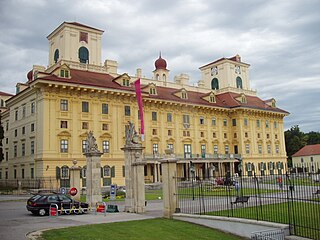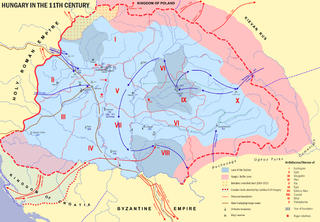Related Research Articles
The Árpád dynasty, consisted of the members of the royal House of Árpád, also known as Árpáds. They were the ruling dynasty of the Principality of Hungary in the 9th and 10th centuries and of the Kingdom of Hungary from 1000 to 1301. The dynasty was named after the Hungarian Grand Prince Árpád who was the head of the Hungarian tribal federation during the conquest of the Carpathian Basin, c. 895. Previously, it was referred to as the Turul dynasty or kindred.
Máté Csák or Matthew III Csák, also Máté Csák of Trencsén, was a Hungarian oligarch who ruled de facto independently the north-western counties of Medieval Hungary. He held the offices of master of the horse (főlovászmester) (1293–1296), palatine (nádor) and master of the treasury (tárnokmester) (1309–1311). He was able to maintain his rule over his territories even after his defeat at the Battle of Rozgony against King Charles I of Hungary. In the 19th century, he was often described as a symbol of the struggle for independence in both the Hungarian and Slovak literatures.

The Palatine of Hungary was the highest-ranking office in the Kingdom of Hungary from the beginning of the 11th century to 1848. Initially, Palatines were representatives of the monarchs, later the vice-regent (viceroy). In the early centuries of the kingdom, they were appointed by the king, and later were elected by the Diet of the Kingdom of Hungary. A Palatine's jurisdiction included only Hungary proper, in the Kingdom of Croatia until 1918 the ban held similar function as the highest office in the Kingdom, monarch's representative, commander of the royal army and viceroy.
Gyula was, according to Muslim and Byzantine sources, the title of one of the leaders, the second in rank, of the Hungarian tribal federation in the 9th–10th centuries. In the earliest Hungarian sources, the title name is only recorded as a personal name.

The Golden Bull of 1222 was a golden bull, or edict, issued by Andrew II of Hungary. King Andrew II was forced by his nobles to accept the Golden Bull (Aranybulla), which was one of the first examples of constitutional limits being placed on the powers of a European monarch. The Golden Bull was issued at the year 1222 diet of Fehérvár. The law established the rights of the Hungarian nobility, including the right to disobey the King when he acted contrary to law. The nobles and the church were freed from all taxes and could not be forced to go to war outside of Hungary and were not obligated to finance it. This was also a historically important document because it set down the principles of equality for all of the nation's nobility. Seven copies of the edict were created, one for each of the following institutions: to the Pope, to the Knights Templar, to the Knights Hospitaller, to the Hungarian king itself, to the chapters of Esztergom and Kalocsa and to the palatine.
Hunor and Magor were, according to Hungarian legend, the ancestors of the Huns and the Magyars. The legend was first promoted in Gesta Hunnorum et Hungarorum. The legend's aim in providing a common ancestry for the Huns and the Magyars was to suggest historical continuum of the Kingdom of Hungary with the Hun Empire. Magyars led by prince Árpád had conquered the area in the 890s. The territory had previously been held by Attila the Hun in the 5th century. The legend thus tried to prove that the Magyars were simply reclaiming their ancient homeland as descendants of Attila. According to Simon of Kéza, Hunor and Magor were the sons of Ménrót, a mythical giant, who he partly identified with Nimrod of the Bible.
Böszörmény, also Izmaelita or Hysmaelita ("Ishmaelites") or Szerecsen ("Saracens"), is a name for the Muslims who lived in the Kingdom of Hungary in the 10–13th centuries. Some of the Böszörmény probably joined the federation of the seven Magyar tribes during the 9th century, and later smaller groups of Muslims arrived in the Carpathian Basin. They were engaged in trading but some of them were employed as mercenaries by the kings of Hungary. Their rights were gradually restricted from the 11th century on, and they were coerced to accept baptism following the establishment of the Christian Kingdom of Hungary. They "disappeared" by the end of the 13th century.

Amadeus Aba or Amade Aba was a Hungarian oligarch in the Kingdom of Hungary who ruled de facto independently the northern and north-eastern counties of the kingdom. He held the office of Palatine several times, and he was also judge royal twice. He was assassinated at the south gate in the city of Kassa by Saxon burghers.

Hont-Pázmány (Hunt-Poznan) was the name of a gens ("clan") in the Kingdom of Hungary. The Gesta Hunnorum et Hungarorummentions that the ancestors of the family, the brothers Hont (Hunt) and Pázmány (Pazman), originally from the Duchy of Swabia in the Holy Roman Empire, arrived in the late 10th century to the court of Grand Prince Géza of the Magyars:
The next arrivals were Hunt and Pazman, two half-brothers, courageous knights of Swabian origin. These two and their retainers had been journeying through Hungary with the intention of passing over the sea when they were detained by Duke Géza, and finally they girded King Stephen with the sword of knighthood at the river Hron, after the German custom.
Ladislaus (III) Kán, was a Hungarian oligarch in the Kingdom of Hungary who ruled de facto independently Transylvania. He held the office of Voivode of Transylvania (erdélyi vajda). Taking advantage of the internal discords within the kingdom, he could maintain his rule over Transylvania until his death even by struggling against the several claimants for the throne.
The "nobles of the Church" were a group of privileged people in the Kingdom of Hungary who possessed lands on the domains of wealthier prelates and were obliged to provide military and other services to their lords.
The ispán or count was the leader of a castle district in the Kingdom of Hungary from the early 11th century. Most of them were also heads of the basic administrative units of the kingdom, called counties, and from the 13th century the latter function became dominant. The ispáns were appointed and dismissed by either the monarchs or a high-ranking royal official responsible for the administration of a larger territorial unit within the kingdom. They fulfilled administrative, judicial and military functions in one or more counties.

The upper nobility was the highest stratum of the temporal society in the Kingdom of Hungary until 1946 when the Parliament passed an act that prohibited the use of noble titles, following the declaration of the Republic of Hungary.

Béla of Macsó was a member of the Rurik dynasty. He was Duke of Macsó (1262–1272) and of Bosnia (1266/1271-1272); and thus he governed the southern provinces of the Kingdom of Hungary.
Zombor, also referred to as Gyula II, was a Hungarian tribal leader in the middle of the 10th century. He visited Constantinople, where he was baptized in 952 with the baptismal name of Stephen.
Torda County was a county in Transylvania between the 11th century and 1876.

The Duke of Transylvania was a title of nobility four times granted to a son or a brother of the Hungarian monarch. The dukes of the first and second creations, Béla (1226–1235) and Stephen of the Árpád dynasty were in fact viceroys with significant authority in Transylvania. The duke of the third creation, Louis, did not administer the province. The fourth duke, Stephen of the Anjou dynasty (1350–1351) did not play any significant role in politics.

A castle warrior or castle serf was a landholder obliged to provide military services to the ispán or head of a royal castle district in the medieval Kingdom of Hungary. Castle warriors "formed a privileged, elite class that ruled over the mass of castle folk" from the establishment of the kingdom around 1000 AD. Due to the disintegration of the system of castle districts, many castle warriors became serfs working on the lands of private landholders in the 13th and 14th centuries; however, some of them were granted a full or "conditional noble" status.

Csák (I) from the kindred Hahót was a Hungarian noble who held several secular positions during the reign of King Béla IV. Initially, he was a strong and influential supporter of the king's son, Duke Stephen, later returned to Béla's allegiance.
The ten-lanced nobles, also Szepes lancers,Spiš lancers, or lance-bearers of Szepes were group of conditional noblemen living in the Szepes region of the Kingdom of Hungary. These nobles were previously part of the contingent assigned with border guard duties in the periphery of the conquered territories in the region. In the thirteenth century, some of these groups were officially integrated into the Hungarian nobility. They received their privileges from King Béla IV of Hungary in 1243. They were obliged to equip ten knights or lancers. They were not subject to the authority of the ispán of Szepes County and tax was collected from them only if the "royal servants" were also required to pay it. Initially, they formed about 40 families, but their number decreased to less than 20 families by the 16th century. They lost their special status in 1804.